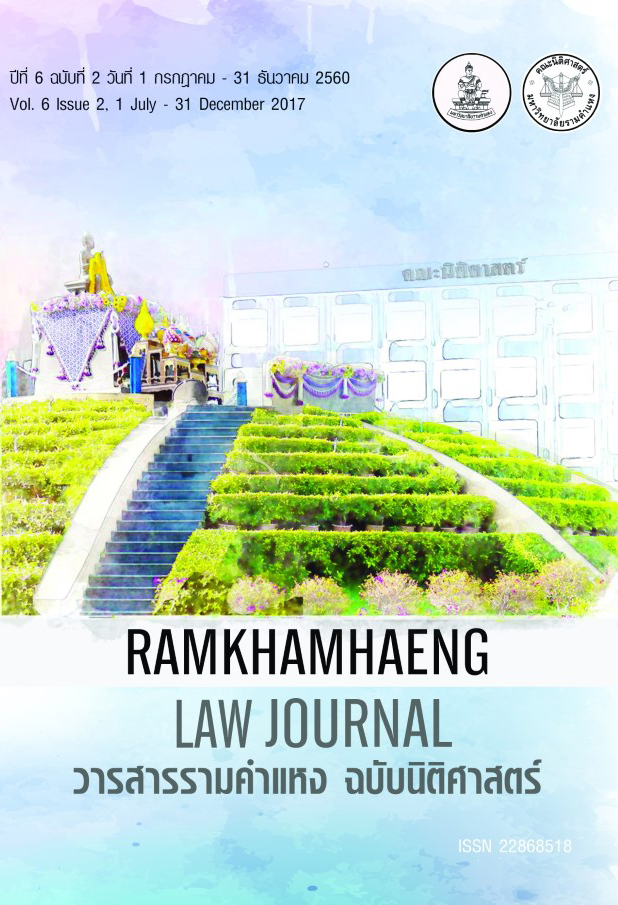การส่งเสริมศิลปะมวยไทย ตามพระราชบัญญัติกีฬามวย พ.ศ.2542
Main Article Content
Abstract
ระเบียบ แบบแผนและประเพณีของศิลปะมวยไทยมีทั้งการยกครู หรือการมอบตัวเป็นศิษย์ การร่ายร าไหว้ครู การแต่งกายของนักมวยไทย เครื่องรางของขลัง วงดนตรีไทย และเครื่องดนตรีไทย ที่ใช้บรรเลงประกอบการชกมวยไทย นอกจากนั้นกระบวนการถ่ายทอดศิลปะมวยไทยตั้งแต่ในยุค อดีตจนถึงในยุคปัจจุบันนั้น มีวิวัฒนาการสืบทอดกันเรื่อยมา ซึ่งจะมีความแตกต่างกันบ้างจากในอดีต ไม่ว่าจะเป็นในเรื่องของการยกครู หรือการมอบตัวเป็นศิษย์ คือในสมัยก่อน ก่อนที่ครูมวยจะ ถ่ายทอดศิลปะมวยไทยให้แก่ศิษย์จะต้องมีการท าพิธียกครู หรือมอบตัวเป็นศิษย์ทุกครั้ง แต่ปัจจุบัน พิธีดังกล่าวมีเพียงบางส านัก บางค่ายมวยไทยที่ถือปฏิบัติอยู่ การร่ายร าไหว้ครูของนักมวยไทยใน สมัยก่อนมีความสวยงามชวนให้ประทับใจ แต่ในปัจจุบันการร่ายร าไหว้ครูเป็นเพียงสิ่งที่ปฏิบัติต่อๆ กันมาเท่านั้น ไม่มุ่งเน้นเท่าที่ควร ความเชื่อเรื่องเครื่องรางของขลังในอดีตสมัยก่อนให้ความส าคัญนับ ถือมาก แต่ปัจจุบันไม่เชื่อมากนัก วงดนตรีที่บรรเลงประกอบการชกมวยไทยในสมัยก่อนใช้การ บรรเลงสด ในปัจจุบันการบรรเลงดนตรีสดก็ยังคงมีอยู่ จะมีบ้างก็บางแห่งที่ใช้วิธีการเปิดแถบบันทึกเสียง หรือแผ่นบันทึกเสียงแทน การแต่งกายของนักมวยไทยในสมัยก่อนไม่มีกติกาก าหนดแน่นอนชัดเจน ในปัจจุบันกติกาก าหนดให้มีการสวมนวม สวมกางเกงตามสีมุมของตัวเอง และสวมกระจับ นักมวยไทย ในสมัยก่อนจะใช้อาวุธมวยไทยอย่างครบถ้วนไม่ว่าจะเป็นหมัด เท้า เข่า และศอกซึ่งแตกต่างกับ นักมวยไทยในสมัยปัจจุบันที่จะใช้อาวุธมวยไทยเพียงเท่าที่ตนเองถนัด ระเบียบ แบบแผนและ ประเพณีของศิลปะมวยไทยในยุคปัจจุบันได้เปลี่ยนแปลงไป เพราะจุดมุ่งหมายในการถ่ายทอดศิลมวยไทยนั้นได้เปลี่ยนไปจากเดิม คือจากเดิมในอดีตนั้นได้มีจุดมุ่งหมายเพื่อการเป็นทหาร หรือนักรบ เป็นหลัก แต่ปัจจุบันมีจุดมุ่งหมายหลายอย่างไม่ว่าจะเป็นในเรื่องของการถ่ายทอดศิลปะมวยไทยเพื่อ ไปเป็นนักมวยไทยอาชีพ เพื่อเป็นผู้ฝึกสอนศิลปะมวยไทย เพื่อเผยแพร่ศิลปะการต่อสู้ของชาติ และ เพื่อการเรียนการสอนของสถาบันการศึกษา ศิลปะมวยไทยในปัจจุบันได้รับความนิยมอย่างกว้างขวาง นอกจากค่ายมวยไทยแล้ว ยังมีการถ่ายทอดโดยโรงเรียนสอนมวยไทยที่เปิดสอนให้กับผู้ซึ่งสนใจ โดยเฉพาะชาวต่างชาติ ซึ่งถือเป็นกีฬาอาชีพอย่างเต็มตัวประเภทหนึ่งในยุคปัจจุบัน ที่ได้รับความ นิยมอย่างแพร่หลายไปสู่ประเทศต่างๆ หรือในทวีปต่างๆ ซึ่งถ้าจะมองในแง่บวกแล้วถือได้ว่ามวยไทย นั้นได้รับการยอมรับไปสู่ในระดับสากลมากขึ้น แต่ถ้าเราหันมามองในอีกแง่มุมหนึ่งต้องยอมรับว่าได้มี การพัฒนาจนกลายเป็นธุรกิจในเชิงกีฬาการต่อสู้ทั้งในประเทศ และต่างประเทศ โดยมีการจัดให้มี การแข่งขันอยู่เป็นประจ าสม่ าเสมอ อย่างไรก็ตามศิลปะมวยไทยที่ได้ตกทอดมาสู่ปัจจุบันนี้ไม่ว่าจะ เป็นการไหว้ครูศิลปะท่าทางการต่อสู้ รวมไปถึงดนตรีที่ใช้บรรเลงท านองเพลงในการไหว้ครูและการ แสดงการต่อสู้ในศิลปะมวยไทยนั้น ก็ยังคงด ารงอยู่แม้จะมีบ้างบางส่วนที่เกิดการเปลี่ยนแปลงไปตาม กระแสสังคมของทุนนิยมก็ตาม แต่ก็ยังคงไว้ซึ่งเอกลักษณ์ของมรดกทางวัฒนธรรมไทยที่มีมายาวนาน ของชาติไทย และพร้อมที่จะพัฒนาก้าวสู่สากลให้ทั่วโลกได้ประจักษ์และด้วยเหตุผลนี้เองจึงได้มีการ ตราพระราชบัญญัติกีฬามวย พ.ศ.2542 ขึ้นเพื่อที่จะควบคุมการจัดการแข่งขันชกมวย อีกทั้งยังเป็น การส่งเสริมกีฬามวยให้มีมาตรฐาน ตลอดจนส่งผลถึงทางด้านสวัสดิการให้กับบุคลากรที่เกี่ยวข้อง ซึ่งได้แก่ นักมวย และบุคคลในวงการกีฬามวยได้แก่ นายสนามมวย ผู้จัดการนักมวย ผู้จัดรายการ แข่งขันมวย หัวหน้าค่ายมวย ผู้ตัดสิน และผู้ฝึกสอนต่อไป ซึ่งพระราชบัญญัติกีฬามวย พ.ศ.2542 นี้ ถือได้ว่าเป็นมาตรการทางกฎหมายในการที่จะควบคุม ดูแล และสนับสนุนส่งเสริมความเป็นศิลปะ ของมวยไทยให้เป็นมรดกทางวัฒนธรรมไทยของชาติไทย แต่ในทางปฏิบัติทางกฎหมาย พระราชบัญญัติกีฬามวย พ.ศ.2542 ก็ยังประสบปัญหาในเรื่องการบังคับใช้กฎหมาย หรือความ ชัดเจนของข้อกฎหมายในการน ามาปฏิบัติใช้ที่เป็นรูปธรรม จึงต้องมีการด าเนินการเพื่อหาแนวทาง แก้ปัญหา และน าไปสู่การแก้ไขบทบัญญัติทางกฎหมายต่อไปในอนาคต
The findings indicated that the customs and traditions of Thai boxing covered the following aspects: Yok Kru, guru worship dance, boxing costumes, good luck charms, traditional music band and the instruments used. Each of these customs and traditions gradually evolved as time passed, resulting in minor different practices at present. Regarding Yok Kru, in the past, the boxing master would pass on the art of Thai boxing to his would-be disciple only after the would-be disciple had performed the Yok Kru ritual, but at present only some boxing gyms strictly adhere to this tradition. Worship dance in the past stressed elaborative and impressive performance, whereas today the dance is conducted just for the sake of having followed the tradition. Good luck charms used to be highly important to boxers in the past, but their importance is increasingly declining nowadays. Accompanying music to the boxing match used to be played by live band only, but now live music could be found sporadically, with some stadiums using recorded music instead. There was no definite pattern for costumes in the past, but at present boxers are required to wear boxing gloves, boxing shorts in the color of their own corner (either red or blue), and boxing jock strap. Previously, boxers would use all parts of their body, be it fists, feet, knees, and elbows, but today Thai boxers use only those body parts of which they are skillful. Particularly noteworthy was the findings that changes in the practice of Thai boxing resulted from the changes in the purpose of training. The sole purpose of boxing training in the past was to prepare young men to become soldiers or warriors, whereas training at present has a variety of aims ranging from training to become professional Thai boxers, to become Thai boxing trainers, to disseminate the national art of fighting, and for the teaching and learning in educational institutions. Currently, Thai boxing art is widely popular. Apart from Thai boxing gyms, there are also Thai boxing schools offering lessons to those interested, particularly to foreigners. Thai boxing is, at present, considered to be a type of professional sports spreading to other countries and continents. From a positive point of view, this means Thai boxing is being accepted at the international level. However, it should also be acknowledged that Thai boxing has been developed to the point that it has become a business-oriented fighting sport, both locally and internationally. Matches are being held regularly. Nevertheless, despite the changes caused by capitalist motives, the majority of the Thai boxing art identities, including worship dance, martial arts, music accompanying worship dance, and Thai boxing performance, remain largely intact and await further development for the time to come. The Boxing Act B.E. 2542 (1999) was enacted in response to be in restraint of competition and establish standard in boxing match. Including receiving benefit for a boxer, host of the event, promoter, manager, head boxing, referee, and trainer. The Boxing Act B.E. 2542 (1999) has been considered to protect this martial art Muay Thai as a national sport and the country’s heritage. While there is no officially recognized the Act, it is necessary to apply to an otherwise authorized boxing commission in the legislation in the future.

